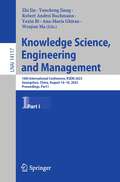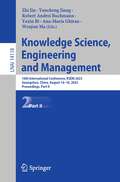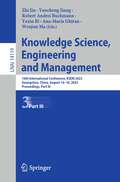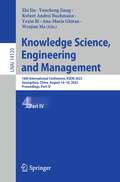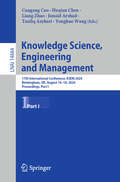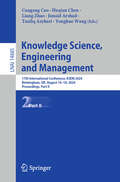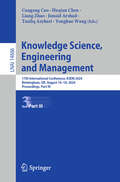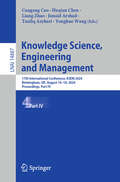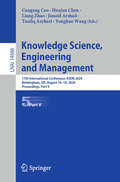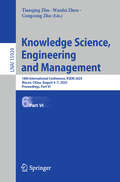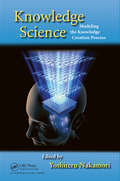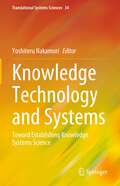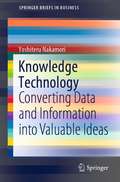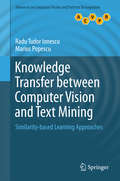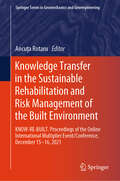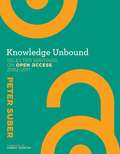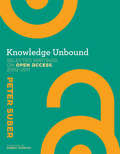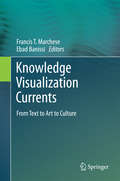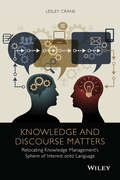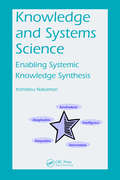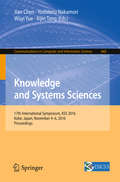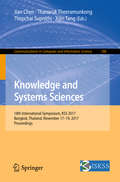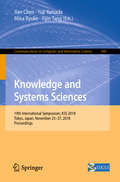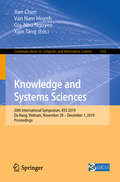- Table View
- List View
Knowledge Science, Engineering and Management: 16th International Conference, KSEM 2023, Guangzhou, China, August 16–18, 2023, Proceedings, Part I (Lecture Notes in Computer Science #14117)
by Yaxin Bi Zhi Jin Robert Andrei Buchmann Wenjun Ma Yuncheng Jiang Ana-Maria GhiranThis volume set constitutes the refereed proceedings of the 16th International Conference on Knowledge Science, Engineering and Management, KSEM 2023, which was held in Guangzhou, China, during August 16–18, 2023. The 114 full papers and 30 short papers included in this book were carefully reviewed and selected from 395 submissions. They were organized in topical sections as follows: knowledge science with learning and AI; knowledge engineering research and applications; knowledge management systems; and emerging technologies for knowledge science, engineering and management.
Knowledge Science, Engineering and Management: 16th International Conference, KSEM 2023, Guangzhou, China, August 16–18, 2023, Proceedings, Part II (Lecture Notes in Computer Science #14118)
by Yaxin Bi Zhi Jin Robert Andrei Buchmann Wenjun Ma Yuncheng Jiang Ana-Maria GhiranThis volume set constitutes the refereed proceedings of the 16th International Conference on Knowledge Science, Engineering and Management, KSEM 2023, which was held in Guangzhou, China, during August 16–18, 2023. The 114 full papers and 30 short papers included in this book were carefully reviewed and selected from 395 submissions. They were organized in topical sections as follows: knowledge science with learning and AI; knowledge engineering research and applications; knowledge management systems; and emerging technologies for knowledge science, engineering and management.
Knowledge Science, Engineering and Management: 16th International Conference, KSEM 2023, Guangzhou, China, August 16–18, 2023, Proceedings, Part III (Lecture Notes in Computer Science #14119)
by Yaxin Bi Zhi Jin Robert Andrei Buchmann Wenjun Ma Yuncheng Jiang Ana-Maria GhiranThis volume set constitutes the refereed proceedings of the 16th International Conference on Knowledge Science, Engineering and Management, KSEM 2023, which was held in Guangzhou, China, during August 16–18, 2023. The 114 full papers and 30 short papers included in this book were carefully reviewed and selected from 395 submissions. They were organized in topical sections as follows: knowledge science with learning and AI; knowledge engineering research and applications; knowledge management systems; and emerging technologies for knowledge science, engineering and management.
Knowledge Science, Engineering and Management: 16th International Conference, KSEM 2023, Guangzhou, China, August 16–18, 2023, Proceedings, Part IV (Lecture Notes in Computer Science #14120)
by Yaxin Bi Zhi Jin Robert Andrei Buchmann Wenjun Ma Yuncheng Jiang Ana-Maria GhiranThis volume set constitutes the refereed proceedings of the 16th International Conference on Knowledge Science, Engineering and Management, KSEM 2023, which was held in Guangzhou, China, during August 16–18, 2023. The 114 full papers and 30 short papers included in this book were carefully reviewed and selected from 395 submissions. They were organized in topical sections as follows: knowledge science with learning and AI; knowledge engineering research and applications; knowledge management systems; and emerging technologies for knowledge science, engineering and management.
Knowledge Science, Engineering and Management: 17th International Conference, KSEM 2024, Birmingham, UK, August 16–18, 2024, Proceedings, Part I (Lecture Notes in Computer Science #14884)
by Huajun Chen Liang Zhao Cungeng Cao Junaid Arshad Taufiq Asyhari Yonghao WangThe five-volume set LNCS 14884, 14885, 14886, 14887 & 14888 constitutes the refereed deadline proceedings of the 17th International Conference on Knowledge Science, Engineering and Management, KSEM 2024, held in Birmingham, UK, during August 16–18, 2024. The 160 full papers presented in these proceedings were carefully reviewed and selected from 495 submissions. The papers are organized in the following topical sections: Volume I: Knowledge Science with Learning and AI (KSLA) Volume II: Knowledge Engineering Research and Applications (KERA) Volume III: Knowledge Management with Optimization and Security (KMOS) Volume IV: Emerging Technology Volume V: Special Tracks
Knowledge Science, Engineering and Management: 17th International Conference, KSEM 2024, Birmingham, UK, August 16–18, 2024, Proceedings, Part II (Lecture Notes in Computer Science #14885)
by Huajun Chen Liang Zhao Cungeng Cao Junaid Arshad Taufiq Asyhari Yonghao WangThe five-volume set LNCS 14884, 14885, 14886, 14887 & 14888 constitutes the refereed deadline proceedings of the 17th International Conference on Knowledge Science, Engineering and Management, KSEM 2024, held in Birmingham, UK, during August 16–18, 2024. The 160 full papers presented in these proceedings were carefully reviewed and selected from 495 submissions. The papers are organized in the following topical sections: Volume I: Knowledge Science with Learning and AI (KSLA) Volume II: Knowledge Engineering Research and Applications (KERA) Volume III: Knowledge Management with Optimization and Security (KMOS) Volume IV: Emerging Technology Volume V: Special Tracks
Knowledge Science, Engineering and Management: 17th International Conference, KSEM 2024, Birmingham, UK, August 16–18, 2024, Proceedings, Part III (Lecture Notes in Computer Science #14886)
by Huajun Chen Liang Zhao Cungeng Cao Junaid Arshad Taufiq Asyhari Yonghao WangThe five-volume set LNCS 14884, 14885, 14886, 14887 & 14888 constitutes the refereed deadline proceedings of the 17th International Conference on Knowledge Science, Engineering and Management, KSEM 2024, held in Birmingham, UK, during August 16–18, 2024. The 160 full papers presented in these proceedings were carefully reviewed and selected from 495 submissions. The papers are organized in the following topical sections: Volume I: Knowledge Science with Learning and AI (KSLA) Volume II: Knowledge Engineering Research and Applications (KERA) Volume III: Knowledge Management with Optimization and Security (KMOS) Volume IV: Emerging Technology Volume V: Special Tracks
Knowledge Science, Engineering and Management: 17th International Conference, KSEM 2024, Birmingham, UK, August 16–18, 2024, Proceedings, Part IV (Lecture Notes in Computer Science #14887)
by Huajun Chen Liang Zhao Cungeng Cao Junaid Arshad Taufiq Asyhari Yonghao WangThe five-volume set LNCS 14884, 14885, 14886, 14887 & 14888 constitutes the refereed deadline proceedings of the 17th International Conference on Knowledge Science, Engineering and Management, KSEM 2024, held in Birmingham, UK, during August 16–18, 2024. The 160 full papers presented in these proceedings were carefully reviewed and selected from 495 submissions. The papers are organized in the following topical sections: Volume I: Knowledge Science with Learning and AI (KSLA) Volume II: Knowledge Engineering Research and Applications (KERA) Volume III: Knowledge Management with Optimization and Security (KMOS) Volume IV: Emerging Technology Volume V: Special Tracks
Knowledge Science, Engineering and Management: 17th International Conference, KSEM 2024, Birmingham, UK, August 16–18, 2024, Proceedings, Part V (Lecture Notes in Computer Science #14888)
by Huajun Chen Liang Zhao Cungeng Cao Junaid Arshad Taufiq Asyhari Yonghao WangThe five-volume set LNCS 14884, 14885, 14886, 14887 & 14888 constitutes the refereed deadline proceedings of the 17th International Conference on Knowledge Science, Engineering and Management, KSEM 2024, held in Birmingham, UK, during August 16–18, 2024. The 160 full papers presented in these proceedings were carefully reviewed and selected from 495 submissions. The papers are organized in the following topical sections: Volume I: Knowledge Science with Learning and AI (KSLA) Volume II: Knowledge Engineering Research and Applications (KERA) Volume III: Knowledge Management with Optimization and Security (KMOS) Volume IV: Emerging Technology Volume V: Special Tracks
Knowledge Science, Engineering and Management: 18th International Conference, KSEM 2025, Macao, China, August 4–7, 2025, Proceedings, Part VI (Lecture Notes in Computer Science #15924)
by Wanlei Zhou Tianqing Zhu Congcong ZhuThe six-volume proceedings set LNAI 15919, 15920, 15921, 15922, 15923 and 15924 constitutes the refereed proceedings of the 18th International Conference on Knowledge Science, Engineering and Management, KSEM 2025, held in Macao, China during August 4–7, 2025. The 106 papers and 66 short papers are included in these proceedings were carefully reviewed and selected from 354 submissions. They focus on all aspects of the exchange of research in artificial intelligence, data science, knowledge engineering, AI safety, large language models, and related frontier areas.
Knowledge Science: Modeling the Knowledge Creation Process
by Yoshiteru NakamoriExplaining how to improve our knowledge-based society, this book addresses problems in collecting, synthesizing, coordinating, and creating knowledge. It provides knowledge engineering tools and a framework for integrating knowledge creation, discovery, and management. The text covers knowledge technology, knowledge management, knowledge discovery and data mining, knowledge synthesis, knowledge justification, and knowledge construction. Experienced researchers in decision science, artificial intelligence, systems engineering, behavioral science, and management science present new methods for creating technological innovation from existing knowledge, such as IT techniques, organizational theory, and mathematical systems theory.
Knowledge Technology and Systems: Toward Establishing Knowledge Systems Science (Translational Systems Sciences #34)
by Yoshiteru NakamoriThis book discusses technology and systems to create valuable ideas from data through the construction of knowledge. The primary concern is to make better decisions about economic and management issues in today’s information-flooded society. Human creative activity is in the realm of soft technology, with no physical entity to operate. Focusing on the ability of knowledge as judgment power, this definition results: “Knowledge technology is soft technology that underpins the human creative activities of converting data and information into knowledge, creating new ideas based on that knowledge and validating those ideas.” That definition includes a wide range of soft technologies developed in informatics, management studies, and systems science. The knowledge system creates ideas from data and knowledge through knowledge technologies. Based on the proposition that knowledge emerges by the interaction between explicit and tacit knowledge, another definition is possible: “The knowledge system is a system that promotes interaction between codified and personalized knowledge and creates ideas for solving a specific problem.” Codified knowledge includes data and information, while personalized knowledge is empirical knowledge or wisdom that is difficult to put into words. Building a knowledge system requires mathematical or intelligent knowledge technology and participatory knowledge technology to create or manage codified knowledge and personalized knowledge. For example, a company builds cross-sectional knowledge systems by gathering human resources from various departments, according to the purpose, as in new product development or sales promotion. Chapter 1 defines knowledge technology and the knowledge system and organizes the challenges in their development, while Chapters 2 through 9 introduce mathematical or intelligent knowledge technologies by researchers at the forefront of knowledge technology development.
Knowledge Technology: Converting Data and Information into Valuable Ideas (SpringerBriefs in Business)
by Yoshiteru NakamoriThis book reviews creative technologies that underpin the human activities of converting data and information into knowledge, creating new ideas based on that knowledge, and validating those ideas. The book calls such creative technology “knowledge technology” and explores its challenges in the age of big data. Today, artificial intelligence and big data are successfully performing pattern recognition and decision making on behalf of humans, who are incapable of processing large amounts of information instantly and accurately. In using only past data, however, there are limits to future predictions with artificial intelligence and big data. Humans need to take the lead in predicting or creating the future by trying to understand why data emerged. Knowledge technology contributes to that understanding, regardless of the field of origin. As a matter of fact, knowledge technology includes many technologies developed in informatics, management study, and systems science. The desirable features of knowledge technology are the complementary use of rational and intuitive approaches, the integration of results from quantitative and qualitative analyses, and the cooperation between artificial intelligence and humans.
Knowledge Transfer between Computer Vision and Text Mining
by Radu Tudor Ionescu Marius PopescuThis ground-breaking text/reference divergesfrom the traditional view that computer vision (for image analysis) and stringprocessing (for text mining) are separate and unrelated fields of study,propounding that images and text can be treated in a similar manner for thepurposes of information retrieval, extraction and classification. Highlightingthe benefits of knowledge transfer between the two disciplines, the textpresents a range of novel similarity-based learning (SBL) techniques founded onthis approach. Topics and features: describes a variety of SBL approaches,including nearest neighbor models, local learning, kernel methods, andclustering algorithms; presents a nearest neighbor model based on a noveldissimilarity for images; discusses a novel kernel for (visual) wordhistograms, as well as several kernels based on a pyramid representation; introducesan approach based on string kernels for native language identification; containslinks for downloading relevant open source code.
Knowledge Transfer in the Sustainable Rehabilitation and Risk Management of the Built Environment: KNOW-RE-BUILT. Proceedings of the Online International Multiplier Event/Conference, December 15-16, 2021 (Springer Series in Geomechanics and Geoengineering)
by Ancuța RotaruThis book showcases the valuable contributions made during the online event entitled The International Conference on Knowledge Transfer in the Sustainable Rehabilitation and Risk Management of the Built Environment. The conference was held on December 15–16, 2021, and was organized as a multiplier event of the European project Rehabilitation of the Built Environment in the Context of Smart City and Sustainable Development Concepts for Knowledge Transfer and Lifelong Learning (RE-BUILT). This book specifically retains the same main themes explored in the book titled Critical Thinking in the Sustainable Rehabilitation and Risk Management of the Built Environment – CRIT-RE-BUILT. The papers included in this book are mostly authored by partners in the project’s consortium and cover various aspects of civil engineering knowledge transfer in crucial areas, to address different perspectives and significant challenges related to the sustainable built environment. The book seeks to provoke ideas and discussions, particularly in the areas where risk management and sustainable rehabilitation of the built environment intersect, ranging from reducing hazard risks to enhancing sustainable rehabilitation efforts in the field
Knowledge Unbound: Selected Writings on Open Access, 2002--2011
by Peter Suber Robert DarntonPeter Suber has been a leading advocate for open access since 2001 and has worked full time on issues of open access since 2003. As a professor of philosophy during the early days of the internet, he realized its power and potential as a medium for scholarship. As he writes now, "it was like an asteroid crash, fundamentally changing the environment, challenging dinosaurs to adapt, and challenging all of us to figure out whether we were dinosaurs." When Suber began putting his writings and course materials online for anyone to use for any purpose, he soon experienced the benefits of that wider exposure. In 2001, he started a newsletter -- the Free Online Scholarship Newsletter, which later became the SPARC Open Access Newsletter -- in which he explored the implications of open access for research and scholarship. This book offers a selection of some of Suber's most significant and influential writings on open access from 2002 to 2010. In these texts, Suber makes the case for open access to research; answers common questions, objections, and misunderstandings; analyzes policy issues; and documents the growth and evolution of open access during its most critical early decade.
Knowledge Unbound: Selected Writings on Open Access, 2002-2011 (The\mit Press Ser.)
by Peter SuberInfluential writings make the case for open access to research, explore its implications, and document the early struggles and successes of the open access movement. Peter Suber has been a leading advocate for open access since 2001 and has worked full time on issues of open access since 2003. As a professor of philosophy during the early days of the internet, he realized its power and potential as a medium for scholarship. As he writes now, “it was like an asteroid crash, fundamentally changing the environment, challenging dinosaurs to adapt, and challenging all of us to figure out whether we were dinosaurs.” When Suber began putting his writings and course materials online for anyone to use for any purpose, he soon experienced the benefits of that wider exposure. In 2001, he started a newsletter—the Free Online Scholarship Newsletter, which later became the SPARC Open Access Newsletter—in which he explored the implications of open access for research and scholarship. This book offers a selection of some of Suber's most significant and influential writings on open access from 2002 to 2010. In these texts, Suber makes the case for open access to research; answers common questions, objections, and misunderstandings; analyzes policy issues; and documents the growth and evolution of open access during its most critical early decade.
Knowledge Visualization Currents
by Francis T. Marchese Ebad BanissiThis text reviews the evolution of the field of visualization, providing innovative examples from various disciplines, highlighting the important role that visualization plays in extracting and organizing the concepts found in complex data. Features: presents a thorough introduction to the discipline of knowledge visualization, its current state of affairs and possible future developments; examines how tables have been used for information visualization in historical textual documents; discusses the application of visualization techniques for knowledge transfer in business relationships, and for the linguistic exploration and analysis of sensory descriptions; investigates the use of visualization to understand orchestral music scores, the optical theory behind Renaissance art, and to assist in the reconstruction of an historic church; describes immersive 360 degree stereographic visualization, knowledge-embedded embodied interaction, and a novel methodology for the analysis of architectural forms.
Knowledge and Discourse Matters
by Lesley CraneThis book provides a practical approach to harnessing knowledge in organizations. Its focus is on knowledge sharing, tacit knowing, and a view of knowledge as an accomplishment in social interaction. The aim of this book is to explore and show how the phenomena of trust, risk and identity, as contexts constructed by speakers themselves, influence and mediate knowledge sharing in organizational encounters. The research particularly reveals how tacit knowledge (knowing), affects the scope and directions of everyday conversation. The first part of the book presents a comprehensive critical appraisal and analysis of the field of organizational knowledge management, followed by an introduction to the theory and methodology of discourse analysis, and a view of tacit knowing drawn from studies in implicit learning. The second part reports the detailed analysis and findings of original field research, investigating how participants in regular organizational meetings, including a discussion forum, manage the business of sharing knowledge. From the perspective of the research methodology, drawing on Discursive Psychology, knowledge is approached as an accomplishment in social interaction, with talk and text shown to be constructive, functional and action-oriented. Presents a rigorous, evidence-based approach to Knowledge Management using original research Approaches discourse as the location of knowledge work, and the site to which knowledge management practice should be focused Positions the actions of knowledge work in everyday talk and text, thus giving practitioners a ready toolset to improve their strategies, practices and understanding of knowledge within organizations Knowledge and Discourse Matters: Relocating Knowledge Management's Sphere of Interest onto Language is a great reference for organizational leaders, knowledge managers, and human resource managers. Dr. Lesley Crane is an independent consultant specializing in knowledge management, and technology supported learning for adults (e-learning). Much of her consultancy work involves providing strategic advice and research on the effective use of e-content, e-tools and the use of new technologies in the delivery of teaching and learning. Prior to working as a consultant, Lesley was Managing Director of her own SME business specializing in creative e-learning design and development for public and private sector organizations.
Knowledge and Systems Science: Enabling Systemic Knowledge Synthesis
by Yoshiteru NakamoriIntegrating ideas from the fields of systems science and knowledge science, Knowledge and Systems Science: Enabling Systemic Knowledge Synthesis shows how to create and justify various pieces of knowledge systemically. Written by one of the foremost experts in this area, the book presents approaches for the systemic integration of knowledge, which
Knowledge and Systems Sciences
by Wuyi Yue Jian Chen Xijin Tang Yoshiteru NakamoriThis book constitutes the refereed proceedings of the 17th International Symposium, KSS 2016, held in Kobe, Japan, in November 2016. The 21 revised full papers presented were carefully reviewed and selected from 48 submissions. The papers cover topics such as: Algorithms for Big Data; Big Data and education; Big Data and healthcare; Big Data and tourism; Big Data and social media oriented knowledge discovery and data mining, text mining, recommendation system, etc; Big Data, social media and societal management; creation of agent-based social systems sciences; collective intelligence; complex system modeling and complexity; decision analysis and decision support systems; internet+ and agriculture; internet+ and open innovation; knowledge creation, creativity support, awareness support, etc. ; knowledge systems engineering and knowledge management; meta-synthesis and advanced modeling; opinion dynamics and opinion mining; OR on knowledge and systems sciences; problem structuring methods and system methodologies toward wicked problems; service systems science; smart city; social dynamic network modeling; Web intelligence.
Knowledge and Systems Sciences: 17th International Symposium, KSS 2016, Kobe, Japan, November 4-6, 2016, Proceedings (Communications in Computer and Information Science #660)
by Jian Chen, Yoshiteru Nakamori, Wuyi Yue and Xijin TangThis book constitutes the refereed proceedings of the 17th International Symposium, KSS 2016, held in Kobe, Japan, in November 2016.The 21 revised full papers presented were carefully reviewed and selected from 48 submissions. The papers cover topics such as: Algorithms for Big Data; Big Data and education; Big Data and healthcare; Big Data and tourism; Big Data and social media oriented knowledge discovery and data mining, text mining, recommendation system, etc; Big Data, social media and societal management; creation of agent-based social systems sciences; collective intelligence; complex system modeling and complexity; decision analysis and decision support systems; internet+ and agriculture; internet+ and open innovation; knowledge creation, creativity support, awareness support, etc.; knowledge systems engineering and knowledge management; meta-synthesis and advanced modeling; opinion dynamics and opinion mining; OR on knowledge and systems sciences; problem structuring methods and system methodologies toward wicked problems; service systems science; smart city; social dynamic network modeling; Web intelligence.
Knowledge and Systems Sciences: 18th International Symposium, KSS 2017, Bangkok, Thailand, November 17–19, 2017, Proceedings (Communications in Computer and Information Science #780)
by Jian Chen, Thanaruk Theeramunkong, Thepchai Supnithi and Xijin TangThis book constitutes the refereed proceedings of the 18th International Symposium, KSS 2017, held in Bangkok, Thailand, in November 2017.The 21 revised full papers presented were carefully reviewed and selected from 63 submissions. This year KSS 2017 provides opportunities for presenting interesting new research results, facilitating interdisciplinary discussions, and leading to knowledge transfer under the theme of "Artificial Intelligence and Information Systems for Knowledge, Technology and Service Management".
Knowledge and Systems Sciences: 19th International Symposium, KSS 2018, Tokyo, Japan, November 25-27, 2018, Proceedings (Communications in Computer and Information Science #949)
by Jian Chen Xijin Tang Yuji Yamada Mina RyokeThis book constitutes the refereed proceedings of the 19th International Symposium, KSS 2019, held in Tokyo, Japan, in November 2018.The 20 revised full papers presented were carefully reviewed and selected from 54 submissions. This year KSS 2018 provides opportunities for presenting interesting new research results, facilitating interdisciplinary discussions, and leading to knowledge transfer under the theme of "Knowledge Acquisition from Structured and Unstructured Data for Effective Social Implementation".
Knowledge and Systems Sciences: 20th International Symposium, KSS 2019, Da Nang, Vietnam, November 29 – December 1, 2019, Proceedings (Communications in Computer and Information Science #1103)
by Jian Chen Xijin Tang Van Nam Huynh Gia-Nhu NguyenThis book constitutes the refereed proceedings of the 20th International Symposium on Knowledge and Systems Sciences, KSS 2019, held in Da Nang, Vietnam, in November 2019. The 14 revised full papers presented were carefully reviewed and selected from 31 submissions. This year KSS provides opportunities for presenting interesting new research results, facilitating interdisciplinary discussions, and leading to knowledge transfer under the theme of "Knowledge Science in the Age of Big Data".
